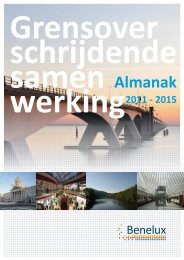The North Seas Countries' Offshore Grid Initiative - Initial ... - Benelux
The North Seas Countries' Offshore Grid Initiative - Initial ... - Benelux
The North Seas Countries' Offshore Grid Initiative - Initial ... - Benelux
You also want an ePaper? Increase the reach of your titles
YUMPU automatically turns print PDFs into web optimized ePapers that Google loves.
In the use of data it is important to recognise that:<br />
1. <strong>The</strong> level of renewable generation, in particular, the level and location of<br />
offshore renewables in projections, is likely to be the parameter with the most<br />
significant impact in determining which offshore grid configuration design best<br />
serves the region’s socio-economic interests. Other parameters that change<br />
that impact on market flows are also likely to influence future grid<br />
development; of these, the assumed level of CO2 costs is probably one of the<br />
most important variables.<br />
2. <strong>The</strong> <strong>North</strong> <strong>Seas</strong> Countries are committed to addressing climate change and<br />
reducing emissions in the longer term. Although there are EU-wide RES targets<br />
up to 2020, there are none beyond this point. <strong>The</strong>re is therefore significant<br />
uncertainty over the level of renewable generation in the <strong>North</strong> <strong>Seas</strong> Countries<br />
in the period 2020 – 2030, as there are various possible pathways to<br />
decarbonisation.<br />
<strong>The</strong> reviewed and updated data was further developed for use in market modelling tools<br />
by the TSOs (see Appendix A 1).<br />
As the updated Reference and Decarbonisation scenarios did not differ significantly with<br />
respect to the overall RES share for the region, it was decided to proceed with just one<br />
scenario for the year 2030 which is referred to as the NSCOGI dataset of summer 2011 or<br />
“Reference Scenario” in this text. Key figures for this scenario are described in more detail<br />
in Appendix A 2.<br />
<strong>The</strong> evolution of the system in terms of installed generating capacities between the year<br />
2020 and 2030 is shown in Figure 3-2. <strong>The</strong> year 2020 is based on scenario EU2020 from<br />
the TYNDP 2012. This scenario, in which the 2020 targets are met, is based on the<br />
National Renewable Energy Action Plans (NREAPs) of the European Member states. This<br />
scenario is compared here with the situation in 2030, represented by the NSCOGI<br />
Reference Scenario.<br />
Figure 3-2 Comparison of installed capacities (in GW) in the NSCOGI perimeter in the years 2020 (Scenario<br />
EU2020) and 2030 (NSCOGI Reference Scenario)<br />
Page 19 of 142










